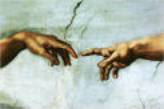
I Believe
by Tom Maguire

What are
beliefs?
There’s an intriguing story told about that eye-catching insect, the
bumblebee. In summertime it is frequent to see its plump form buzzing around
gardens or other natural areas in search of nectar and pollen to feed its
young. You have probably spotted one flying around tipsily, pollinating
flowers and gathering food. They are difficult to miss because of their
insistent buzz and striking yellow and black stripes. However, you might be
surprised to learn that, according to the laws of aeronautics, bumblebees can’t
fly! Restated in another way: the
laws of aeronautics still cannot explain how bumblebees fly. In other words
this aeronautical model is not altogether wrong, but certainly defective.

Our beliefs are just like this model for flying, they are constructions
of how the world works, built up through our daily experience. There is no
problem with that unless we succumb to the temptation to believe that our
model really explains how the world works. The aeronautical equivalent would
be expectations of lots of bumblebees toppling out of the sky.
Beliefs as Generalisations
In his book “Changing Belief Systems”, Robert Dilts defines beliefs
as generalisations. According to Dilts they are generalisations about the
connection between different experiences. For example one day in the middle of
one of your boss’s tantrums you happen to notice that he is wearing red
socks. You think it a little unusual and record it in your memory bank.
However, the next time the boss goes off the deep end he happens to be wearing
the same red socks. This double sequence of events, seeing the boss in a bad
mood and seeing his red socks only has to happen to most of us three times and
we’ll start believing that there is a causal relationship between the two
events. From then on we’ll begin to expect the boss to start bellowing if we
notice he has his red socks on because we have generalised the relationship
between the two experiences into a reality when in fact it is a coincidence.
The important point is that it is we ourselves who forge the connection
between the two experiences. It is a mental construct. That is the nature of
belief - we construct it in our minds.
The positive angle, of course, is that we can also learn to deconstruct,
or change our beliefs. I believe
that this is window of opportunity. If we can reconstruct our beliefs to make
our lives more fulfilling and happier then we should grasp the chance. Why not
learn to laugh at the boss and his red socks instead of seeing them as an
ominous sign? Why not ignore them and avoid provoking a confrontation because
we believe one should take place?
The Placebo effect

Another striking example of the power of belief to alter our lives is the
placebo effect. Dilts looked into the research on placebos done in the USA
where every new drug has to be tested against a placebo. He concluded that
more than a third of the time placebos had the same effect as the drug being
tested. This means that in over thirty-three percent of cases belief in the
placebos effected a cure equivalent to the available chemical stimulant. This
may not be so surprising if we reflect that vaccination works by eliciting the
body’s own defence system and that, possibly, belief has the same
immunological effect. However we explain it, the placebo effect remains a
powerful example of the capacity of our beliefs to transform our lives. In
education, for example, we can turn the placebo effect to our advantage simply
by expecting students to learn well. Those who swallow the pill of our
expectations will learn more than the subject matter; they will learn the
benefits of constructing positive beliefs. Unfortunately our
beliefs are often self-limiting and we don’t actually expect as much as we
should. As Nelson Mandela put it,
"...
our deepest fear is that we are powerful beyond measure."
A
model for beliefs
In his book Dilts goes further and offers a framework which enables us to
explore the way in which we construct beliefs. The model of organisation he
proposes distinguishes 5 different levels : Identity – Beliefs –
Capabilities – Behaviour - Environment. For example if a child is having
problems learning maths, a parent might talk about the problem from any one of
the 5 viewpoints:
|
The impact on the student of an isolated analysis will range widely
depending on the level chosen, from Identity : “I am not intelligent.” to
Environmental : “I can’t do maths because of the surrounding
noise.”. Dilts invites us to view beliefs not as an isolated occurrence but as one
level of the system. It is important to note that the higher levels of
Identity and Belief have a knock-on effect and that working at these levels is
probably more efficient. The function of beliefs, for example, is to activate
capabilities and behaviours. The student above is encouraged to improve his
maths strategies and make an effort by the belief that in this way she will be
better able to solve other problems. In the same way enhancing a learner’s
Environment, through supportive feedback, will also underpin their chances of
believing long enough in themselves to allow change to take place, despite
temporary failures. Belief is a construct and can be analysed as part of a
system. It affects and is influenced by the other levels of the system. It is
not to be confused with reality.
Belief and
Faith
I believe that there is a difference
between belief and faith. It is a difference in quality. Both terms suppose a
leap in the dark, but faith is a belief which matters deeply, because it makes
the world more sensible to the believer. Belief goes something like this:

-
Do you believe that Australia exists?
-
Oh, yes, I saw it on a TV documentary the other night.
-
Did you believe the documentary? (Back to square one.)
Faith, however, goes more like this:
-
Do you believe we were created by God?
-
Well, no, I’m an atheist.
-
Oh, how does that help you to make sense of life?
In other words, faith deals with the unanswered questions which seem to haunt humans. We appear to be doomed, probably by the structure of our brain, to seek to understand the whole meaning of things, including our own existence. This innate impulse towards holistic comprehension of life has lead humans to depths of despair and also to peaks of beauty.

This is surely what Art in all its forms is seeking : to
give more meaningfulness to life, be it in the form of a symphony, a classic
play, a good book or a great painting? This is also what religious faiths are
striving to offer us: the ultimate meaning of existence. Sin, after all, is
just the name for the contradictory human experience of needing wholeness yet
being unable to attain it. The Existentialist philosophers made a brave
attempt to live on a horizontal plane with no reference to anything outside
mankind. Yet Camus was haunted by what he called “le soupçon d’autre
chose”, the suspicion that there is more to living than what we can quite
explain. Sartre himself also admitted that there was no explanation which
could account for the suffering of an innocent child. They had come up against
‘sin’, which doesn’t admit philosophy with ease.
We are makers-of-sense and we cannot
but help look for patterns in what we experience around us. Christianity, for
example, follows the Jewish tradition and sees in the two Genesis creation
stories the expression of how life can be given meaning,
the affirmation that creation exists for a purpose, not just by
accident. The rest of the biblical story is an attempt to analyse and convey
the meaningfulness of living. The ancient Greeks, the Maya and the Celts also
created a meaning for their world through myth, as all cultures have, because
they needed a holistic explanation of how their world was.
Many contemporaries prefer the modern myths of science to those of
religion. It is curious to reflect that Science doesn’t claim to give a
whole explanation to life but we have such a thirst for complete explanations
that we attribute it that capacity. This conjures up that fun picture of
bumblebees falling out of the sky.
![]()
BIODATA:
Tom
Maguire has a BA (English), M-ès-Lettres (French) and Philology degree
(Spain). He has 29 years experience in TEFL in France and Spain. At present he
teaches EFL in a Spanish State high school near Barcelona and is participating
in a pioneering Catalan website to give academic support to students, teachers
and parents (www.edu365.com). He is
interested in using Neuro-linguistic Programming (Nlp) to enhance Learning to
Learn. He is a Master Practitioner in Nlp and manages a listserv for those
interested in Nlp in Education.
Website:
http://www.xtec.es/~jmaguire
E-mail: jmaguire@pie.xtec.es